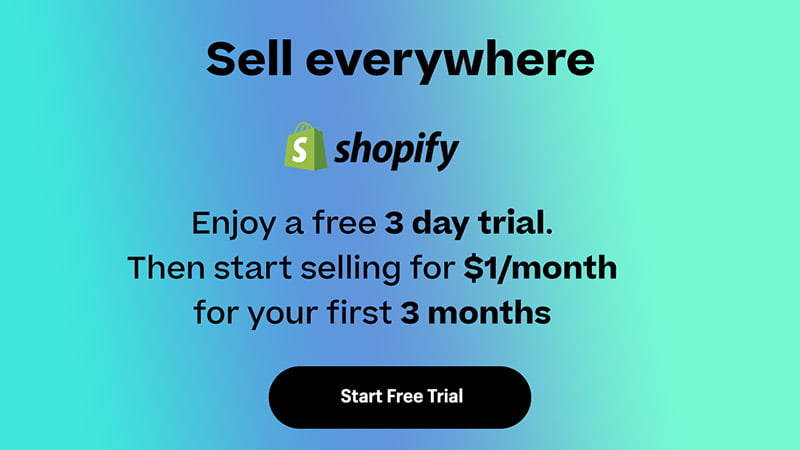Disclosure: We may earn a commission or fee from some of the links in our content. However, this does not affect our recommendations. Learn more.
Quick answer: Artsadd is a great option if you’re running a niche print-on-demand store and want to sell unique products like custom sneakers, yoga mats, or car accessories.
It’s not the fastest shipper, and you won’t find premium customer support, but it’s solid if you know what you’re doing and want something different from the usual POD providers.
I’ve worked with dozens of suppliers over the last 10+ years in ecommerce and dropshipping.
Platforms like Printful and Printify are well-known for basics — t-shirts, hoodies, mugs. But I stumbled across Artsadd when I was hunting for a shoe-focused supplier with global fulfillment.
After testing their platform myself, placing orders, and comparing it to other POD tools, here’s my honest, hands-on review.
Artsadd Pros & Cons
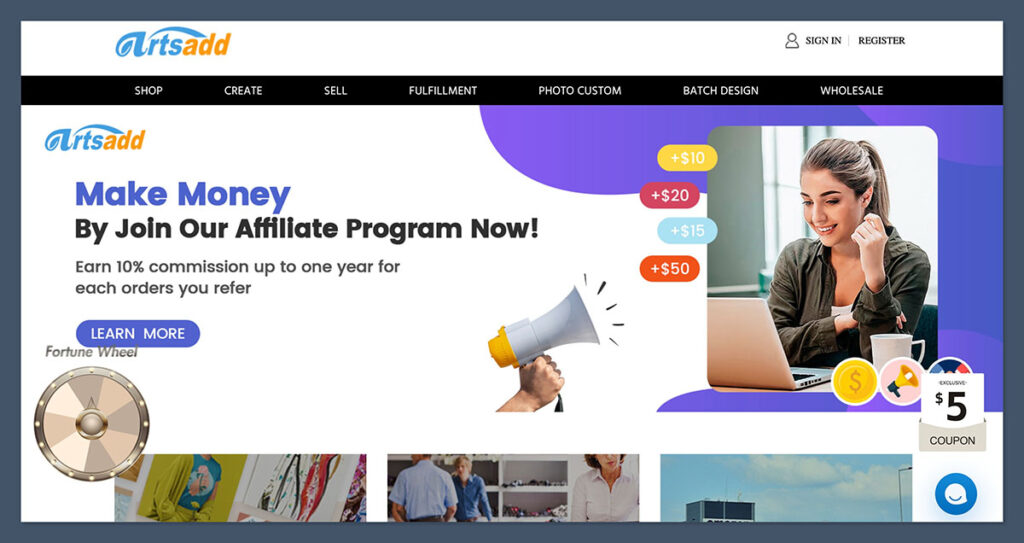
Artsadd is a specialised print-on-demand platform that stands out in a very saturated market.
Unlike most POD providers that all seem to offer the same generic catalog of mugs, tees, and hoodies, Artsadd doubles down on unique products — with a big focus on custom shoes, which is what initially caught my attention.
From my experience, it’s not trying to be a full-service POD platform for everyone.
It’s best suited for experienced dropshippers and store owners who already understand how to set expectations around longer shipping and want to test higher-margin products in less competitive categories.
You won’t find a sleek user experience or top-tier support. But you will find products that other POD suppliers just don’t offer, and that’s where Artsadd’s value shines.
Overall Rating
Great
4.2 / 5
Best for:
- Niche dropshipping stores selling unique or novelty products
- Shopify users who want to test trends fast
- Sellers looking to stand out with custom accessories and footwear
- Brands that don’t rely on 2–5 day delivery
Free to use:
- No monthly subscription
- No listing fees
- You only pay when you sell
What I Like About Artsadd
Artsadd has some real strengths — but only if you know how to use them. These pros come from hands-on use, not marketing hype.
✔️ Standout shoe catalog
You’ll find high tops, low tops, casual sneakers, and slip-ons with full-print design capabilities. Print quality is solid, and shoes feel premium. This alone makes it a goldmine for niche designs.
✔️ Competitive pricing
Shoes cost $25–$30 on average, but they sell for $55–$75 — a much better markup than typical t-shirts. Accessories like car seat covers and yoga mats also offer strong margin potential.
✔️ Custom branding options
You can upload your logo for packaging or include branded inserts. It’s not full custom packaging, but enough to look professional.
✔️ Smooth Shopify integration
One of the easiest POD apps I’ve connected to Shopify. Orders sync fast, and fulfillment is handled without a hitch.
✔️ Wide variety of niche products
They don’t just do shoes. You can design car floor mats, handbags, wall art, yoga mats, and more. Perfect for building niche stores around specific hobbies, lifestyles, or subcultures.
✔️ No subscription fees
It’s 100% free to get started. You only pay when orders come in, which makes it ideal for testing new product lines or one-off launches.
What I Don’t Like About Artsadd
Artsadd isn’t perfect, and there are some drawbacks that make it less suitable for new sellers or brands built around fast delivery and polished UX.
❌ Slower shipping times
Shipping from China adds 10–20 days for standard delivery. You can use express, but it’s costly. If you’re competing with Amazon on delivery, this won’t work for you.
❌ Basic design tool and mockups
The product preview tool works, but it’s not pretty. Mockups are flat and don’t show products in real-world settings. You’ll need to invest in Placeit or similar tools for quality visuals.
❌ Limited support options
There’s no live chat or phone support. Everything runs through email, and while they reply within 1–2 business days, this isn’t ideal when you’ve got time-sensitive customer issues.
❌ Strict return policy
Returns are only accepted for defects or misprints. There’s no “no-questions-asked” return policy. You’ll need to absorb costs if a customer just changes their mind.
❌ No native Etsy integration
You can’t connect Etsy directly to Artsadd. You’ll need to use a third-party tool like OrderDesk or manage fulfillment manually. It adds complexity if Etsy is part of your strategy.
Bottom Line
If you’re looking for a low-cost, high-margin way to test niche POD products — especially shoes — Artsadd is a strong option.
But it’s not beginner-friendly, and it’s not designed for sellers who need quick delivery, polished mockups, or hand-holding.
If you know what you’re doing and want to carve out a unique spot in the market, it can absolutely work in your favour.
My Experience Using Artsadd
Signing up to Artsadd was refreshingly simple — no payment details required, no over-complicated onboarding funnel. All it takes is your email, and you’re in.
That said, the first impression of the dashboard was underwhelming if you’re used to platforms like Printful or Gelato.
The interface is a bit dated and stripped down, but it’s functional and focused.
After logging in, the setup flow was very seller-driven. I was prompted to upload my designs, browse product categories, and connect my Shopify store.
There’s no AI wizard, no pre-built store suggestions, no coaching overlays.
That might sound like a downside, but in reality, it works in your favour if you’re not a beginner and just want to get your catalog built quickly without fluff.
Artsadd is clearly geared towards people who already understand the print-on-demand workflow.
If you’ve used platforms like Printify or JetPrint before, you’ll find it intuitive enough. But if you’re looking for something with a guided experience or visual coaching, it’s not here.
What I Noticed Right Away
- The platform is clearly built for bulk customisation
You can tell from the layout and tools that it’s designed for sellers uploading 10, 20, even 100+ designs across a range of products. It’s built for production and efficiency, not hand-holding. - White-label branding is standard
There’s no extra fee or process for removing Artsadd’s branding. You get a blank-slate product experience out of the box, which is ideal if you’re building a private-label or custom brand. - Mockup generator is basic but functional
You won’t get lifestyle mockups or realistic renders. The previews are flat and minimal. For basic storefronts, that’s fine. But for ad creatives or Etsy listings, you’ll want to supplement with Placeit or your own product photography. - No subscription model
Unlike some platforms that push paid tiers, Artsadd is refreshingly direct. You don’t pay monthly fees or unlock features via a subscription. You just pay per order, which makes it low risk when testing new products. - Navigation is product-first
There’s no deep learning curve here. The product list is easy to filter, and the designer tool loads quickly. If you know what you’re looking for, you can get a new product live in 15–20 minutes, no issues.
What Could Be Better
The UI isn’t slick. It feels more like a backend dashboard than a polished app.
There’s minimal guidance or UX niceties.
While I personally don’t mind that — I just want to get my designs live and selling — it’s worth noting for people coming from tools like Sellfy or Shopify’s built-in POD apps, which feel more refined.
I also noticed that some product variants didn’t generate previews consistently. Not a deal-breaker, but slightly frustrating when trying to show all angles of a shoe or bag to potential customers.
Verdict: Artsadd doesn’t try to be pretty — it tries to be fast and functional. If you’ve run a store before, you’ll appreciate the efficiency.
If you’re brand new to POD, you might find the lack of onboarding a bit cold. Either way, once you’ve built a product or two, it clicks.
Artsadd Products: What’s on Offer?
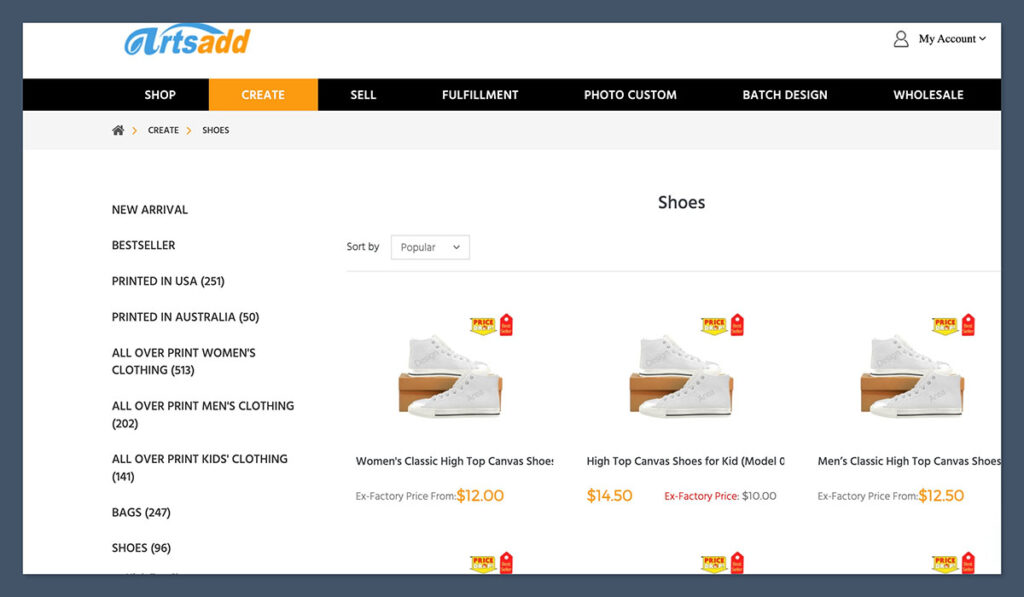
Artsadd’s biggest strength — and the reason I first gave it a shot — is the range of products you can customise and sell.
Most POD platforms stick to the basics: t-shirts, mugs, and hoodies.
Artsadd flips that model on its head and leads with what I’d call niche-forward inventory — think shoes, car seat covers, yoga mats, and large bags.
This is where real margin potential shows up. These aren’t products your customer sees every day on Instagram or Etsy.
So when you put a great design on a product like custom sneakers or a travel bag, it immediately looks fresh — and that gives you pricing power.
I’ve tested multiple products from their lineup over the last 18 months, both as personal samples and in live stores.
In terms of both print quality and perceived value, I was genuinely impressed with several items, especially the footwear and fitness gear.
Popular Product Categories
| Product Category | Sample Product | Base Price (USD) | Suggested Retail | Notes |
|---|---|---|---|---|
| Shoes | Low-top canvas sneakers | $28 | $59.99 | Best-seller, great quality |
| Car Accessories | Front seat covers (pair) | $38 | $74.99 | Niche audience, high margins |
| Yoga / Fitness | Printed yoga mat | $24 | $49.99 | Good for wellness niches |
| Bags & Accessories | Large tote / overnight bag | $29 | $54.99 | Unique design potential |
| Apparel (basic) | Unisex hoodie | $26 | $44.99 | OK quality, better options elsewhere |
Real-World Impressions
I ordered the shoes, yoga mat, and overnight bag to test before pushing them live in one of my niche stores. Here’s how they stacked up:
- Custom shoes felt premium right out of the box. Stitching was clean, colours were sharp, and the packaging looked brandable without needing full custom boxes. I’ve worn mine regularly, and they’ve held up just as well as mainstream canvas shoes.
- The yoga mat was thick enough for everyday use, with a nice grip and clear print. Great for niches like wellness, astrology, or motivational fitness.
- The tote bag came with durable zippers, strong handles, and a lot of usable space — not just a novelty item. Customers actually use this stuff, which helps with reviews and repeat orders.
Hidden Opportunities
Where Artsadd really shines is in helping you build a catalog that’s different from every other store selling POD basics. If you’re in a sub-niche — like anime, urban fashion, wellness, pets, or spirituality — these items give you a serious edge.
Consider these angles:
- Car accessories: Great for pet lovers, horror fans, or car mod communities.
- Travel bags: Work well for spiritual symbols, floral art, or motivational phrases.
- Shoes: Endless potential for fan art, minimalist design, or loud graphics.
Pair these with TikTok, Etsy, or Instagram ads and you’ve got a scroll-stopper that doesn’t scream “dropshipped”.
Verdict: If you’re planning to sell hoodies or basic apparel only, Artsadd might disappoint.
But if your strategy is to build a brand around more unique, bold products — especially footwear, fitness, and accessories — this is one of the best POD options available. The range alone gives you creative flexibility most other platforms just can’t match.
Shipping & Delivery: The Big Trade-Off
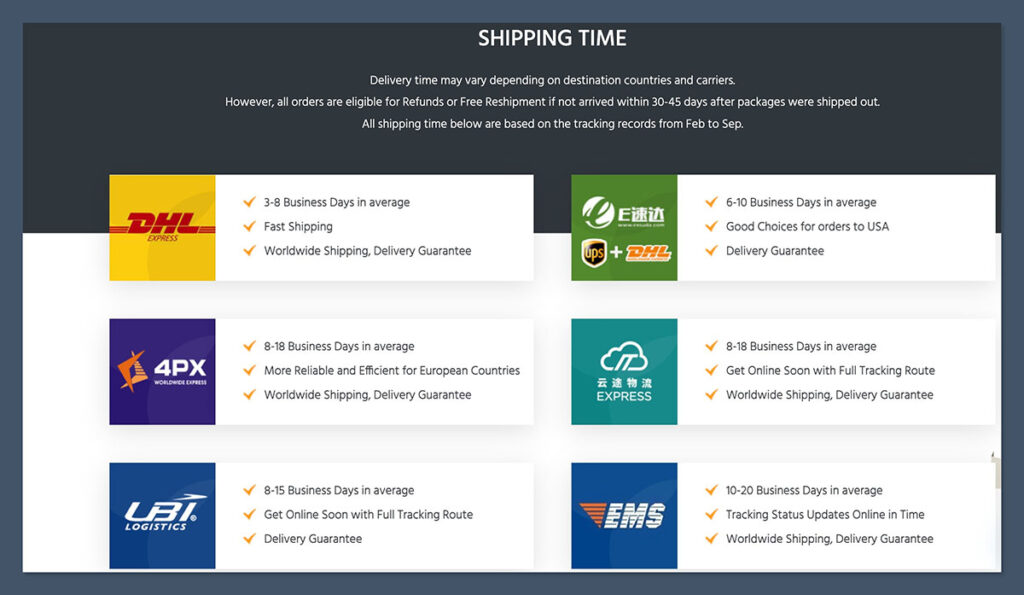
One of the biggest considerations when working with Artsadd is shipping speed — or rather, the lack of it.
Since all orders are fulfilled and shipped from China, you’re trading delivery time for access to unique, high-margin products that aren’t available through most US-based print-on-demand suppliers.
This isn’t a surprise, and to be fair, it’s clearly communicated on their website.
But it’s something every serious dropshipper needs to factor in.
If your audience expects 2–5 day shipping like Amazon Prime, you’re going to hit friction.
But if you’re building a brand around custom, made-to-order products, longer shipping is often accepted — especially if you’re upfront about it.
Shipping Times (From My Orders)
| Region | Standard Shipping | Express Shipping | Notes |
|---|---|---|---|
| USA | 12–20 days | 5–10 days | My orders arrived in ~13 days |
| Canada | 14–21 days | 5–10 days | Slightly longer, but reliable |
| Europe | 15–25 days | 7–12 days | Slower for remote areas |
I tested several orders to the US and Europe, and while nothing arrived super fast, they all showed up within the estimated window.
The tracking updates were consistent — not always in real time, but enough to keep customers informed.
That said, if you’re targeting customers who need their order ASAP (like for birthdays, events, or holidays), Artsadd isn’t the right supplier.
You’ll likely lose those sales to faster competitors.
Packaging Experience
Another thing worth pointing out is the packaging. Every product I received came in plain, unbranded packaging — no mention of Artsadd, no third-party markings, just clean and simple.
For me, that’s a huge plus.
- It keeps the experience 100% white-label
- It gives your brand more control over customer perception
- You can easily add your own branding through inserts or stickers
If you’re building a branded experience (or planning to scale with influencer seeding or unboxing campaigns), this is a big win.
While you won’t get custom printed boxes by default, it does avoid the cheap, over-branded packaging that kills credibility.
Customer Expectations & Communication
The key here is setting expectations upfront. I include clear shipping timelines on my product pages, FAQs, and order confirmation emails.
I also emphasise that products are made-to-order — which helps customers understand why delivery takes time.
As long as you’re not hiding it, most people are fine waiting for a product that feels unique and personalised.
And if you’re targeting niches like fashion-forward sneaker drops or fitness lifestyle gear, that waiting period can actually build anticipation — especially if your marketing is strong.
Verdict: Shipping is the trade-off you make to access Artsadd’s product range and pricing.
It’s not built for impulse buyers or last-minute gifting. But if you’re clear with your messaging and lean into the “made for you” angle, it won’t hold you back.
In my experience, most customers were happy to wait 2–3 weeks for something they couldn’t find anywhere else.
Shopify Integration: Is It Easy?
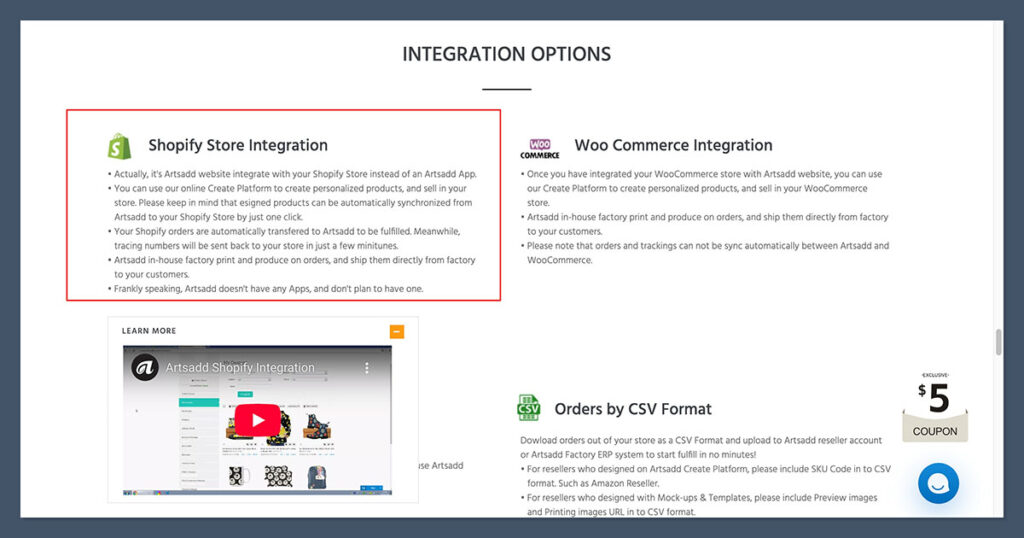
One of the main reasons I gave Artsadd a proper test was because it integrates directly with Shopify — and to their credit, they’ve kept the process incredibly straightforward.
I connected a demo store in under 10 minutes, and it synced my first product without any hiccups.
The setup flow is clean: you log into your Artsadd dashboard, head to the integrations section, and connect your Shopify store with just a few clicks.
Once you’re synced, any product you publish from Artsadd gets pushed directly into your Shopify product catalog — complete with images, descriptions, and variants.
For anyone used to the Printify or Printful workflow, Artsadd feels very similar, which makes the transition easy if you’re switching suppliers or testing new product lines in your store.
Key Integration Features
Here’s what stood out during testing:
- Syncs products and variants
Once connected, any product you create in Artsadd — including multiple sizes or colour options — appears correctly in your Shopify backend with all variants linked. - Order automation
When a customer places an order in your Shopify store, it automatically shows up in your Artsadd dashboard. There’s no manual pushing, which reduces mistakes and saves time. - Auto-fulfillment
After the order is paid, Artsadd handles production and shipping automatically. You don’t need to confirm or trigger it manually unless you’ve adjusted default settings. - Supports branded options
If you’ve uploaded your logo or want to add custom branding elements to your packaging, those preferences carry over with the synced orders.
This all worked smoothly for me across multiple test orders.
Fulfillment timelines, tracking numbers, and order statuses updated correctly in both platforms — which, in my experience, isn’t always guaranteed with POD integrations.
Where It Falls Short
That said, Artsadd doesn’t offer native Etsy integration, which is a clear gap if you’re running multi-channel sales.
You’ll need to either fulfill Etsy orders manually by uploading shipping details or use a tool like OrderDesk or ShopUpz to bridge the gap.
Also, if you’re trying to connect via API or use it with WooCommerce or BigCommerce, be ready to handle some technical setup.
There’s no plug-and-play option outside Shopify, so the experience is much more advanced for anything beyond that.
Another thing worth mentioning — the mockups imported into Shopify are pretty basic.
They look fine for a starting point, but they won’t win you clicks on social or Etsy. I usually rework the visuals with Placeit before publishing to my store or running ads.
Verdict: If you’re running a Shopify store, the Artsadd integration is one of the simplest I’ve tested.
It works quietly in the background, with no syncing errors or fulfillment issues. For Shopify users, it’s plug-and-play.
For Etsy or API users, it’s more manual — but not impossible if you’re comfortable with some backend tools. Overall, this is a solid POD app if Shopify is your main storefront.
Artsadd Product Quality: My Honest Opinion
Let’s be honest — in the world of print-on-demand, product quality can make or break your store.
Even if your design is on point, if the item feels cheap or falls apart after a few wears, you’re going to lose repeat business fast.
I’ve run multiple test orders through Artsadd and shipped samples to both myself and select customers.
Here’s how it stacks up.
Shoes
Shoes are clearly Artsadd’s flagship product — and it shows.
I’ve ordered multiple pairs across different designs and styles, and the results have been consistently solid.
- Build: The shoes feel sturdy right out of the box. Thick rubber soles, reinforced eyelets, and decent stitching make them feel like something you’d find in a brick-and-mortar shoe store.
- Print quality: Colours came out vibrant and aligned perfectly with my uploaded files. No smudging, no fading, and no off-centre designs.
- Comfort & Fit: True to size based on standard US sizing. I’ve worn them for full days without discomfort — no breaking in needed.
Verdict: These rival the quality of popular canvas sneakers like Vans or Converse — at a fraction of the production cost. For custom shoe sellers, they’re a strong value play.
Yoga Mats & Car Accessories
Next up, I tested some less traditional POD items — a printed yoga mat and a set of car seat covers.
- Durability: Both items felt well-made, with thick materials and solid stitching. The car seat covers slipped on easily and didn’t stretch out or tear during installation.
- Print quality: Designs printed clearly with no pixelation or colour issues. They looked exactly like the digital mockup.
- Packaging: Both items had a mild plastic or chemical smell on arrival — common with direct-from-factory goods — but it aired out in about a day.
Verdict: These niche products held up well and exceeded my expectations. They’re perfect for themed stores — like fitness, astrology, pets, or car enthusiast brands — where visual design is everything.
Apparel
This is where things get more average. I tried their basic tees and hoodies just to see how they’d compare to heavyweights like Printful or Bella+Canvas options.
- T-shirts: The fabric felt thin and generic. Good enough for casual wear, but definitely not premium.
- Hoodies: Slightly better — soft on the inside, print held well after washing, but again, nothing that would justify a $60 price tag.
- Sizing: Fits were mostly accurate, though I’d advise adding sizing charts to avoid confusion for international customers.
Verdict: The apparel is usable, especially for budget or casual lines, but I wouldn’t build a store around it. Stick to accessories and shoes if you want to stand out.
Overall Verdict: Artsadd delivers great quality where it counts — shoes, accessories, and niche products. You get what you pay for, and in this case, that’s a competitive, reliable product that can support a real brand.
Just make sure to order samples before going all in on any product category.
Can You Make a Profit with Artsadd?
Absolutely. In fact, the margins on Artsadd products are better than what you’ll find with most mainstream POD suppliers — especially when it comes to accessories and footwear.
These aren’t saturated, low-ticket items. You’ve got room to price based on value and design, not just cost-plus.
Here’s what the numbers look like from my store tests:
Sample Margin Table
| Product | Base Cost | Shipping | Retail Price | Gross Margin |
|---|---|---|---|---|
| Custom sneakers | $28 | $7 | $59.99 | ~$25 |
| Yoga mat | $24 | $6 | $49.99 | ~$20 |
| Car seat covers (set) | $38 | $9 | $74.99 | ~$28 |
These margins give you flexibility with ad spend, influencer deals, or bundling offers — all without eating into profits the way low-margin apparel often does.
You also don’t need to worry about subscription fees, hidden tier upgrades, or minimum order thresholds.
That means you can test new product ideas with minimal risk, especially if you’re running TikTok organic, UGC ads, or lightweight influencer campaigns.
Pro Tips from My Experience
- Test on TikTok or Instagram Reels first: These platforms love unique visuals. A pair of flaming skeleton high-tops or zodiac-themed car mats will stop scrolls.
- Use Placeit for mockups: Artsadd’s native mockups are functional, but not ad-worthy. Upgrading your product photos instantly improves your conversion rate.
- Bundle for higher AOV: Pair a yoga mat with a matching tote, or offer shoes with matching socks. Small increases in cart value make a big difference on paid traffic.
Verdict: Artsadd gives you room to breathe on pricing. The margins are healthy, especially in niches where competition is low and perceived value is high.
If you’ve got a strong brand angle or good creative, there’s real money to be made here — even with standard ad costs. Just don’t expect discounts unless you negotiate bulk orders directly.
Returns, Support & Customer Service
One of the more noticeable trade-offs with Artsadd is the lack of hands-on customer service.
Unlike some print-on-demand platforms that offer live chat or even phone support during business hours, Artsadd keeps it minimal — everything is handled by email.
Now, that doesn’t mean they’re unresponsive. In fact, I’ve been surprised by how quickly they respond — usually within 24 to 48 hours.
But if you’re coming from a platform like Printful or Gooten that has live chat or ticket systems with priority queues, you’ll feel the difference.
With Artsadd, you’re more or less managing everything from your inbox.
This makes it important to take control of your store’s front-end customer experience.
If a customer emails you asking where their order is or wants to return an item, you need to handle that communication directly, rather than relying on Artsadd to step in.
What’s Covered by Artsadd?
The return and refund policy is clear — but very limited:
- Defective or misprinted items
Covered fully. They’ll issue a replacement or refund after reviewing photos and order details. - Lost packages
If a package is confirmed lost by the carrier (not just delayed), they’ll replace the item and resend it at no cost to you or your customer. - Customer changes their mind or doesn’t like the product
Not covered. This one’s on you. You’ll need to decide whether to eat the cost, offer store credit, or handle it another way. - Incorrect address or customer error
Also not covered. If the order was placed with a mistake in the address and it doesn’t arrive, you’ll need to reorder or resolve the issue yourself.
My Experience With Support
Most of the issues I encountered were minor — one order arrived with a slightly off-centre print, and another got delayed in transit.
I emailed support with screenshots and order numbers, and both were resolved within two business days.
They reprinted the product without pushback, which I appreciated.
Still, don’t expect proactive updates, escalation teams, or a customer portal to track support tickets. This is a lean operation — if you want something done fast, you’ll need to follow up and stay on top of it yourself.
Verdict: Artsadd’s support is barebones but functional. If you’re an experienced seller who can manage expectations and solve basic customer issues on your own, it won’t be a problem.
But if you’re looking for a plug-and-play service team to handle returns and complaints for you, this isn’t the platform for that.
Make sure your store’s FAQ, policies, and email templates are tight — because you’re the one doing the frontline work.
Final Verdict: Should You Use Artsadd?
After testing Artsadd extensively across several product types and real customer orders, here’s where I stand: Artsadd is a powerful tool — but only in the right hands.
If you’ve got experience running a print-on-demand store and you’re looking to move beyond the usual mugs, hoodies, and t-shirts, this is a platform worth exploring.
Its real advantage is in the product range — shoes, yoga mats, car accessories, tote bags — items you won’t find on most mainstream POD platforms.
That uniqueness lets you stand out in crowded niches and unlock better margins without fighting over the same overused templates.
But it’s not without limitations.
You’re dealing with longer shipping times, limited customer support, and a hands-off onboarding process.
It’s not a beginner-friendly platform. You’ll need to handle customer communication, set expectations clearly, and be comfortable running support from your own side.
My Experience in Context
Personally, I’ve used Artsadd to test niche designs that simply wouldn’t have worked with other suppliers.
Anime-themed sneakers, gothic travel bags, zodiac-style car seat covers — all of these worked better through Artsadd than through any t-shirt-based platform.
The profit margins were strong, and customer feedback was positive once expectations were set.
Small-batch sneaker drops became one of the easiest ways for me to generate buzz and test new markets.
And because the products felt different from what most POD sellers were offering, my ads converted better, even with slower shipping.
Recommended For:
Artsadd is a smart choice if you:
- Run a niche Shopify store (e.g. anime, astrology, alt fashion, fitness, pets)
- Are testing visual or novelty product ideas on TikTok or Reels
- Want to diversify your print-on-demand catalog beyond clothing
- Are tired of fighting over the same t-shirt and mug traffic
- Can manage customer service yourself and set delivery expectations clearly
Not Recommended For:
Skip Artsadd if you:
- Are brand new to ecommerce and need lots of guidance
- Are building a general store without a specific target audience
- Need fast, domestic shipping with a high-speed fulfillment model
- Expect live chat support or a plug-and-play support system
- Want highly-polished mockups out of the box
Bottom line: Artsadd fills a gap in the POD space for sellers who want to offer unique, higher-margin products and don’t mind sacrificing speed for originality.
If you’ve got the experience to run a lean backend and you know how to build demand with creative marketing, it’s a reliable platform to add to your stack.
But if you’re hoping to launch your first store and scale passively with no customer interaction, you’ll want to start somewhere else.

